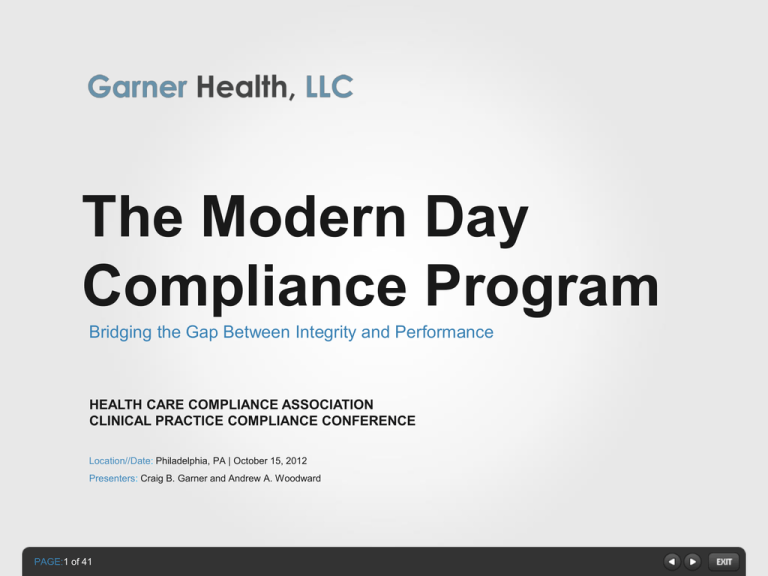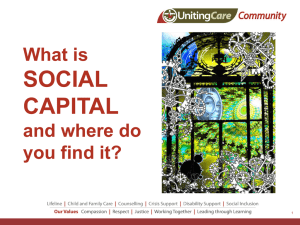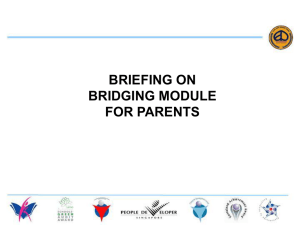The Modern Day Compliance Program
advertisement

The Modern Day Compliance Program Bridging the Gap Between Integrity and Performance HEALTH CARE COMPLIANCE ASSOCIATION CLINICAL PRACTICE COMPLIANCE CONFERENCE Location//Date: Philadelphia, PA | October 15, 2012 Presenters: Craig B. Garner and Andrew A. Woodward PAGE:1 of 41 The Modern Day Compliance Program Bridging the Gap Between Integrity and Performance Why Establish a Compliance Program? PAGE:3 of 41 The Modern Day Compliance Program Bridging the Gap Between Integrity and Performance Yesterday • Demonstrate a commitment to honest and responsible conduct. • Increase the likelihood of preventing, identifying and correcting unlawful and unethical behavior at an early stage. • Encourage employees to report potential problems to allow for appropriate internal inquiry and corrective action. • Minimize any financial loss to government and taxpayers through early detection and reporting, as well as any corresponding financial loss to the provider. PAGE:5 of 41 The Modern Day Compliance Program Bridging the Gap Between Integrity and Performance Today • The Affordable Care Act requires all health care providers to implement formal health care compliance programs as a condition of enrollment in Medicare, Medicaid and the Children’s Health Insurance Program (CHIP). • This compliance program must contain certain core principles established by the Federal Government. • OIG recommends seven elements from the 2010 U.S. Federal Sentencing Guidelines Manual as the basis for these core elements. PAGE:6 of 41 The Modern Day Compliance Program Bridging the Gap Between Integrity and Performance Elements from U.S. Federal Sentencing Guidelines • Implementing clear standards and procedures to prevent and detect violations • Securing appropriate oversight by designated Compliance Officer • Employing due diligence in hiring and assigning personnel • Communication compliance standards and procedures and providing training to employees at all levels • Incorporating procedures for monitoring and auditing, including periodic evaluation of program effectiveness • Maintaining consistent disciplinary mechanisms • Designing a process to investigate and remediate after detecting a violation PAGE:7 of 41 The Modern Day Compliance Program Bridging the Gap Between Integrity and Performance Tomorrow VALUE BASED PURCHASING (VBP) PROGRAM • Hospitals: Beginning October 2012, hospitals face a 1% reduction overall in Medicare payments under the Inpatient Prospective Payment System (IPPS), designed to calculate performance bonuses. By 2015, hospitals showing poor performance may also face additional reductions. • Physicians: Beginning in 2015, the value-based payment modifier applicable to Medicare Fee for Service applies to all groups of 25 or more eligible professionals (including physicians, practitioners and therapists), followed by a complete phasein by 2017. PAGE:8 of 41 The Modern Day Compliance Program Bridging the Gap Between Integrity and Performance Integrity Meets Performance PAGE:9 of 41 The Modern Day Compliance Program Bridging the Gap Between Integrity and Performance Fraud and Abuse Laws after Medicare •The Social Security Amendments •Medicare-Medicaid Anti-Fraud and Abuse Amendments •Omnibus Reconciliation Act •Civil Monetary Penalties Law •Medicare and Medicaid Patient and Program Protection Act •Ethics in Patient Referral Act •Omnibus Budget Reconciliation Act •The Health Insurance Portability and Accountability Act (HIPAA) •The Balanced Budget Act •The Deficit Reduction Act •The Fraud Enforcement and Recovery Act •The Patient Protection and Affordable Care Act PAGE:10 of 41 The Modern Day Compliance Program Bridging the Gap Between Integrity and Performance Core Elements of a Compliance Program •Compliance Officer •Compliance Committee •Code of Conduct •Written Policies and Procedures •Training and Education •Communicating Compliance Issues The OIG recognizes that physician practices differ from hospitals, and financial limitations may impede the scope of certain physician compliance programs. PAGE:11 of 41 The Modern Day Compliance Program Bridging the Gap Between Integrity and Performance Hospital VBP Program The VBP Program is based on a hospital’s total performance score (TPS), which includes, in part, 12 Clinical Process of Care measures (70% of the TPS) in the following categories: •Acute Myocardial Infarction •Heart Failure •Pneumonia •Surgical Care Improvement Project PAGE:12 of 41 The Modern Day Compliance Program Bridging the Gap Between Integrity and Performance Hospital VBP Program (continued) The TPS also includes 8 Patient Experience of Care dimensions (30% of TPS) from the Hospital Consumer Assessment of Healthcare Providers and Systems (HCAHPS) survey: •communication with doctors •communication with nurses •responsiveness of hospital staff •pain management •communication about medication •cleanliness and quietness •discharge information •overall rating PAGE:13 of 41 The Modern Day Compliance Program Bridging the Gap Between Integrity and Performance Physician Value Modifier Scoring For groups with 25 or more physicians, CMS recommends that the following outcome measures be used in the calculation: •30-day post discharge visits •All cause readmissions •Composite of acute prevention quality indicators (pneumonia, UTI, dehydration) •Composite of chronic prevention quality indicators (COPD, heart failure, diabetes) https://www.surveymonkey.com/s/garnerhealth PAGE:14 of 41 The Modern Day Compliance Program Bridging the Gap Between Integrity and Performance Physician Value Modifier Amount Combine each quality measure into a quality composite and each cost measure into a cost composite using the following domains: PAGE:15 of 41 The Modern Day Compliance Program Bridging the Gap Between Integrity and Performance Bridging the Gap Part 1: Financial Alerts PAGE:16 of 41 The Modern Day Compliance Program Bridging the Gap Between Integrity and Performance Alerts Dashboard Augment financial reports with custom “alerts” designed to identify anomalies in accounts receivable and payable each month. The dashboard tracks select accounts, calculates an average value based on actual census, and generates automatic notifications each time any tracked item falls outside the appropriate range. PAGE:17 of 41 The Modern Day Compliance Program Bridging the Gap Between Integrity and Performance Alerts Dashboard A central dashboard monitors all alerts from one location. Hospital or physician management can isolate billing codes from where the alerts are generated, identify the reason for the anomaly and address existing concerns. PAGE:18 of 41 The Modern Day Compliance Program Bridging the Gap Between Integrity and Performance Charge Description Master Track hospital CDMs against regional averages as well as historical averages to confirm charges fall within accepted levels. http://www.oshpd.ca.gov/chargemaster/ http://www.hospitalcompare.hhs.gov/ Alerts occur when charges fall outside the expected range. Alert Triggered PAGE:19 of 41 The Modern Day Compliance Program Bridging the Gap Between Integrity and Performance Bridging the Gap Part 2: Tracing an Excluded Individual PAGE:20 of 41 The Modern Day Compliance Program Bridging the Gap Between Integrity and Performance Tracing Hospital Employees/Vendors Track all officers, employees and vendors against the OIG’s List of Excluded Individuals and Entities (LEIE) http://oig.hhs.gov/exclusions/index.asp PAGE: 2 of 41 The Modern Day Compliance Program Bridging the Gap Between Integrity and Performance Tracing Hospital Employees/Vendors (continued) Upon identification of an excluded entity, a report will calculate all charges attributed thereto. It may also identify areas for further investigation to determine the scope of any financial impact. If appropriate, provider can self disclose any overpayment. PAGE:22 of 41 The Modern Day Compliance Program Bridging the Gap Between Integrity and Performance Tracing Hospital Employees/Vendors (continued) •Calculate financial impact of clinical services or products attributed to an excluded employee or vendor through a direct model. •Calculate financial impact of clinical services or products attributed only in part to an excluded employee or vendor through a pro-rated model. •Hybrid model appropriate based upon available billing and data records. PAGE:23 of 41 The Modern Day Compliance Program Bridging the Gap Between Integrity and Performance Benefits of an Active Compliance Program By taking a proactive approach to identify any early warnings for billing anomalies or excluded employees/vendors, providers: •Demonstrate a commitment to honest and responsible corporate conduct. •Increase the likelihood of preventing, identifying, and correcting unlawful and unethical behavior at an early stage. •Encourage employees to report potential problems to allow for appropriate internal inquiry and corrective action. •Minimize any financial loss to government and taxpayers through early detection and reporting, as well as any corresponding financial loss to the provider. •Enjoy increased bonuses under the VBP programs. PAGE:24 of 41 The Modern Day Compliance Program Bridging the Gap Between Integrity and Performance Form Over Substance Follow HCAHPS Quality Assurance Guidelines v.7.0 •Hospitals must continuously collect and submit HCAHPS data in accordance with the current HCAHPS Quality Assurance Guidelines and the quarterly data submission deadlines. •To participate in the collection of HCAHPS data, a hospital must either (1) contract with an approved HCAHPS survey vendor or (2) self-administer the survey, provided the hospital attends HCAHPS training and meets Minimum Survey Requirements. •Four approved methods of administering the CAHPS Hospital Survey: (1) mail; (2) telephone; (3) mixed (mail followed by telephone); and (4) active interactive voice response. PAGE:25 of 41 The Modern Day Compliance Program Bridging the Gap Between Integrity and Performance RACs, MACs, MICs and ZPICs PAGE:26 of 41 The Modern Day Compliance Program Bridging the Gap Between Integrity and Performance RACs •Recovery Audit Contractor (RAC) Program: This began as a three-year demonstration using RACs to detect and correct improper payments within Medicare. •The original goal of the demonstration program was to determine whether the use of RACs would be a cost-effective way to maintain the integrity of Medicare by ensuring that provider payments were correct. PAGE:27 of 41 The Modern Day Compliance Program Bridging the Gap Between Integrity and Performance MACs •Medicare Administrative Contractors (MACs): Groups that process Part A and Part B claims. MACs oversee claim completion and accuracy. •Due to the scope of their jurisdiction, CMS believes MACs will be able to review discrepancies between the two sets of claims, revise payments and/or increase denials. PAGE:28 of 41 The Modern Day Compliance Program Bridging the Gap Between Integrity and Performance MICs Medicaid Integrity Contractors (MICs): MICs review Medicaid claims in search of inappropriate payments or fraud. MICs also audit Medicaid claims and identify overpayments and areas of high risk for payment errors or fraud. Some possible targets include the following: •Services provided after the death of a beneficiary •Duplicate claims •Unbundling of services •Outpatient claims with service dates that overlap dates of an inpatient stay PAGE:29 of 41 The Modern Day Compliance Program Bridging the Gap Between Integrity and Performance ZPICs Zone Program Integrity Contractors (ZPICs): Formerly known as Program Safeguard Contractors (PSCs), ZPICs serve the same jurisdictions as Medicare Administrative Contractors. ZPICs conduct investigations, aid law enforcement and execute audits of Medicare advantage plans. The ZPIC data analysis program is designed to identify provider billing practices and services that pose the greatest financial risk to Medicare. The data analysis program seeks to: •Identify high risk areas of potential error so that they may be closely monitored. •Establish a baseline so contractors can recognize unusual trends, utilization changes or outright schemes designed to maximize reimbursement unlawfully. PAGE:30 of 41 The Modern Day Compliance Program Bridging the Gap Between Integrity and Performance Additional Considerations PAGE:31 of 41 The Modern Day Compliance Program Bridging the Gap Between Integrity and Performance HITECH and Data Breaches Under HITECH, any covered entity that maintains “unsecured” protected health information (PHI) and discovers a breach of such information must notify each individual whose PHI “has been, or is reasonably believed by the covered entity to have been, accessed, acquired or disclosed as a result of such breach.” PHI must be made “unusable, unreadable or indecipherable” through encryption. •What to do upon discovering a breach? •What are the notice requirements? •What fines may be assessed for a security breach? PAGE:32 of 41 The Modern Day Compliance Program Bridging the Gap Between Integrity and Performance Self Disclosure and Overpayments OIG: Hospitals who wish to voluntarily disclose self-discovered evidence of potential fraud to the OIG may do so under the Provider Self-Disclosure Protocol (SDP). CMS: The Medicare voluntary self-referral disclosure protocol includes a process to enable providers of services and suppliers to self-disclose actual or potential violations of the physician self-referral statute. FISCAL INTERMEDIARY: Should a hospital identify an overpayment, sending a check to Medicare for the appropriate amount may prevent offsets or delays of future claim payments. PAGE:33 of 41 The Modern Day Compliance Program Bridging the Gap Between Integrity and Performance Fair Market Value “Fair market value” refers to the value in “arm’s-length” transactions, consistent with the general market value. Areas of Concern: •Physician employment •Physician practice acquisition •Joint venture arrangements •Call coverage and other personal service agreements •Management services agreements •Co-management arrangements PAGE:34 of 41 The Modern Day Compliance Program Bridging the Gap Between Integrity and Performance Enrollment Improvements and Screening •Enrollment is processed faster (two-thirds reduction in time) •Enrollment is user-friendly (available online) •Enrollment is more reliable (consisting of one system for all enrollees and including up to date information) •Fraudulent providers and suppliers are subjected to extensive, risk-based screening through the new Automated Provider Screening (APS) system (implemented December 31, 2011) •Medical identities checked against Compromised Numbers database •Addresses checked against valid location databases •Revocations, exclusions and felony convictions all checked by new system PAGE:35 of 41 The Modern Day Compliance Program Bridging the Gap Between Integrity and Performance About the OIG OIG website http://oig.hhs.gov/ The Data Bank (National Practitioner Data Bank and Healthcare Integrity and Protection Data Bank) http://www.npdb-hipdb.hrsa.gov HEAT (Stop Medicare Fraud) http://www.stopmedicarefraud.gov/ HHS website http://www.hhs.gov/ PAGE:36 of 41 The Modern Day Compliance Program Bridging the Gap Between Integrity and Performance Craig B. Garner Craig is an attorney and health care consultant, specializing in issues pertaining to modern American health care and the ways it should be managed in its current climate of reform. Craig is also an adjunct professor of law at Pepperdine University School of Law, where he teaches courses on hospital law and the Affordable Care Act. Between 2002 and 2011, Craig was the Chief Executive Officer of Coast Plaza Hospital. He was responsible for administration and oversight of this general acute care hospital providing services to the City of Norwalk and surrounding communities in Southeast Los Angeles County. Additional information can be found at www.craiggarner.com/about. PAGE:39 of 41 The Modern Day Compliance Program Bridging the Gap Between Integrity and Performance Andrew A. Woodward Andrew Woodward is a financial and strategic consultant for health care and other business entities, focusing on financial efficiency, integrity and growth opportunity. In addition to working with companies on a day-to-day basis, Andrew has restructured entire financial tracking and accountability systems for acute care hospitals, improving the institutions’ internal visibility, decreasing and identifying instances of undercharges and overcharges, and maximizing overall profitability. Andrew has more than 10 years of experience in venture funding and strategic partnership development. A coFounder and Partner at Propel Funding Accelerators in Los Angeles, CA, Andrew works with start-ups and small businesses in the areas of financing, operational build-out and corporate strategy. Andrew has been a director at Garner Health since the company ’ s inception. Andrew believes that entrepreneurial thinking is critical to the long-term success of health care institutions, and his expertise in designing systems to increase efficiency while maintaining integrity makes sound strategic improvements in the health care institutions with which he works. Andrew is a graduate of Babson College in Wellesley, MA. For more information, contact andrew@garnerhealth.com. PAGE:40 of 41 The Modern Day Compliance Program Bridging the Gap Between Integrity and Performance Thank You Craig B. Garner and Andrew A. Woodward PAGE:








